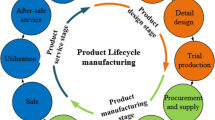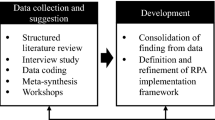Abstract
Shipyard hoisting process is a project type manufacturing process which entails more sophisticated elements and relationships than other kinds of processes, this feature brings particular challenges when constructing a structured description of the process, called enterprise model, to introduce various Computer Integrated Manufacturing (CIM) technologies. However, most of the modelling methods devised so far do not consider the individual demand of project type manufacturing process. Therefore, we envisage the necessity to expand, extend, and refactor current methodologies in order to exploit this remaining dimension. In this line, we present a dedicated method aiming at appropriately modelling the project type manufacturing process, it employs seven collaborative views and task-centric idea to emphasize work flow abstraction without sticking to the material flow abstraction as current methods do, which is the key factor to successfully achieve horizontal functions/organizations integration and vertical management hierarchies integration for this special process. The proposed method adopts semi-formal meta model to interpret its framework, building blocks and constraints graphically and rigorously. All these works are performed taking shipyard hoisting process as example. According to the modelling method, a two-stage Computer Aided Process Planning (CAPP) method is also initiated to demonstrate how the process model can serve as the bridge to converge manufacturing technology and information technology. Furthermore, a CAPP prototype is developed to carry out case study with an actual shipyard hoisting process. The study reveals promising contributions to not only enhancing the industrial competitiveness but also enriching the enterprise modelling research on project type manufacturing process.



















Similar content being viewed by others
Abbreviations
- CAD:
-
Computer aided design
- CAE:
-
Computer aided engineering
- CAPP:
-
Computer aided process planning
- CIM block:
-
Computer integrated manufacturing
- DFD:
-
Data flow diagram
- ERP:
-
Enterprise resource planning
- MBOM MBOM:
-
Manufacturing bill of material
- MES:
-
Manufacturing execution system
- PDM:
-
Product data management
- P/E:
-
Pre-erection block
- PPR-S:
-
Product, process, resource and schedule
- PPR3-S:
-
Product, process, 3 sub-resource and schedule
- RASCI:
-
Responsible, authorize, support, check, inform
- T-PARS:
-
Task, product, activity, resource and schedule
- WBS:
-
Work breakdown structure
References
Zhang, HL (2010) Research on Hoisting Technology of Hull Blocks. Master dissertation, Harbin Engineering University, Harbin, China
Shannon K, Housel TJ, Jansen E, and Silkey T (2012) Benchmarking Dutch and U.S. Naval Shipbuilding: Reducing U.S. Naval Shipbuilding Costs Using Collaborative PLM and 3D Imaging. Naval Postgraduate School Sponsored Report
Kim JH (2008) Automation and robotization of production processes in shipbuilding. In: Poster presentation at the 2008 International Conference on Control, Automation and Systems for the IEEE, Seoul
Lee DH (2014) Robots in the shipbuilding industry. Robot Comput Integr Manufact 30(5):442–450. https://doi.org/10.1016/j.rcim.2014.02.002
Yuji, Sugitani (2004) The Technical Trends and the Future Prospective of the Shipbuilding Industries in Japan. In: Proceeding of the 5th Annual Assembly of the International Institute of Welding (IIW), Osaka, pp 1–12
Stanić V, Hadjina M, Fafandjel N (2018) Toward shipbuilding 40-an industry 40 changing the face of the shipbuilding industry. Brodogradnja 69–3:111–128. https://doi.org/10.21278/brod69307
Andritsos F, Perez JP (2000) The automation and integration of production processes in shipbuilding.” European Commission, Joint Research Center
Agarwala CN, Chaudhary RD (2019) Growth of Shipbuilding in China: The Science, Technology, and Innovation route. Institute of Chinese Studies, Delhi
Vallespir BD, Yves P (2018) Enterprise modelling: from early languages to models transformation. Int J Prod Res 56(8):2878–2896. https://doi.org/10.1080/00207543.2017.1418985
Merchant ME (1990) World trends of importance to intelligent robotic cim systems. Robot Comput Integr Manufact 7(34):255–261. https://doi.org/10.1016/0736-5845(90)90010-6
Laengle S, Modak NM, Merigó JM, De LS (2018) Thirty years of the international journal of computer integrated manufacturing: a bibliometric analysis. Int J Comput Integr Manufact. https://doi.org/10.1080/0951192X.2018.1529434
Zaborowski M (2016) Generalization and Composition-Relationships between Objects of Enterprise Process Control Systems. In Proceedings of the 11th Scientific Conference Internet in the Information Society, pp 405-418
Mertins K, Roland J (2001) Integrated enterprise modelling: a method for the management of change. Prod Plann Control 12(2):9–23. https://doi.org/10.1080/09537280150501248
Bernus P, Nemes L (1996) A framework to define a generic enterprise reference architecture and methodology. Comput Integr Manufact Syst 9(3):179–191. https://doi.org/10.1016/s0951(96)00001-8
ZVEI (2015) The reference architectural model industry 4.0 (RAMI 4.0). https://www.zvei.org/en/subjects/industrie-4-0/the-reference-architectural-model-rami-40-and-the-industrie-40-component/
Koenig PC, Macdonald PL, Lamb T, Dougherty J (1997) The national shipbuilding research program. Ship production symposium, paper number 16: towards a generic product-oriented work breakdown structure for shipbuilding. The National Shipbuilding Research Program
Han SD, Ryu CH, Shin JG, Lee JK (2008) Modeling and simulation of ship panel-block assembly line using Petri nets. Trans Soc CAD/CAM Eng 13(1):36–44
Yu GZ, Kai X, Yong Z (2011) Modeling and analysis of panel hull block assembly system through timed colored petri net. Mar Struct 24(4):570–580. https://doi.org/10.1016/j.marstruc.2011.07.002
Woo JH, Lee KK, Jung HR, Kwon YD, Shin JG (2005) A framework of plant simulation for a construction of a digital shipyard. J Soc Naval Arch Korea 42(2):165–174
Shen H, Nam S, Ju S, Sung S, Shin JG, and Nam JH (2017) Design of an Integrated Production Planning System Framework Based on Simulation Using a Production Information Model. In: Proceedings of the 27th International Ocean and Polar Engineering Conference. International Society of Offshore and Polar Engineers, San Francisco, pp 813–820
Nam JH, Lee JH, Woo JH (2016) Construction of standardized data structure for simulation of mid-term scheduling of shipbuilding process. Int J Comput Integr Manufact 29(4):1–14. https://doi.org/10.1080/0951192X.2015.1066031
Kim Y, Woo JH, Jeong YK, Shin JG (2018) Computational shipyard dynamics. J Ship Prod Des 34(4):355–367. https://doi.org/10.5957/JSPD.170029
Groover Mikell P (2011) Automation, production systems, and computer-integrated manufacturing. Prentice Hall Press, New Jersey
Cha JH, Roh MI, Lee KY (2010) Integrated simulation framework for the process planning of ships and offshore structures. Robot Comput Integr Manufact 26(5):430–453. https://doi.org/10.1016/j.rcim.2010.01.001
Ha S, Ku NK, Roh MI, Hwang HJ (2015) Multibody system dynamics simulator for process simulation of ships and offshore plants in shipyards. Adv Eng Softw 85(jul):12–25. https://doi.org/10.1016/j.advengsoft.2015.02.008
Ku N, Ha S (2014) Dynamic response analysis of heavy load lifting operation in shipyard using multi-cranes. Ocean Eng 83(2):63–75. https://doi.org/10.1016/j.oceaneng.2014.03.026
Cabanillas C, Resinas M, and Ruiz CA (2011) Mixing RASCI matrices and BPMN together for responsibility management. VII Jornadas en Ciencia e Ingeniería de Servicios 2011: 1167. https://doi.org/10.13140/2.1.4769.6960
Acknowledgements
This research is funded by the International Exchange Program of Harbin Engineering University for Innovation-oriented Talents Cultivation. The authors would like to express their gratitude to Computer-Aided Systems and Production Engineering Research Lab. for discussion and assistance.
Author information
Authors and Affiliations
Corresponding author
Additional information
Publisher's Note
Springer Nature remains neutral with regard to jurisdictional claims in published maps and institutional affiliations.
About this article
Cite this article
Liu, M., Meng, M., Shin, J.G. et al. Task-centric method for shipyard hoisting process modelling and its application in CAPP. J Mar Sci Technol 26, 792–811 (2021). https://doi.org/10.1007/s00773-020-00772-z
Received:
Accepted:
Published:
Issue Date:
DOI: https://doi.org/10.1007/s00773-020-00772-z




